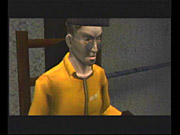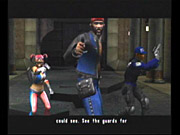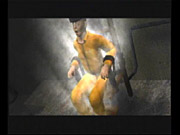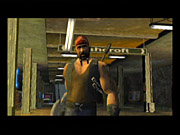Based on the White Wolf pen-and-paper game of the same name, Hunter: The Reckoning is a gaming experience not unlike those found in games like Smash TV, Gauntlet, or even Diablo, where your primary function is to obliterate just about everything that appears on the screen. Not surprisingly, this formula works incredibly well, especially when four players are involved, but there are a few problems with the game--most notably in its control scheme, which isn't very accommodating for melee attacks. In addition, the GameCube version lacks some of the visual detail of its Xbox counterpart, but if you missed out on that version, you'll find Hunter to be an enjoyable, albeit brief, game.

Because of its ties to a pen-and-paper RPG, the story in Hunter: The Reckoning is more involving than in most games of this type, but there are certainly moments when you'll be scratching your head and wondering what exactly just happened. The game begins at the Ashcroft prison, where a man is executed by the electric chair. But unbeknownst to the prison's inhabitants, the execution opens up a rift that allows spirits trapped in the prison to run amok and possess any bodies within the immediate area. Fortunately, four characters with the ability to see these demons fend off the attack and seal the prison, preventing the demons from spreading to the local town. A few years later, however, a rave is held at the prison to celebrate the execution, and this opens the rift, setting the demons loose on the town. The same four characters, known simply as hunters, return to finish the job they started. The story then takes a few twists and turns from there.
The four hunters--the avenger, the martyr, the defender, and the judge--are not unlike the different character types from games like Gauntlet, because each one is proficient in a particular skill, and each has a default set of weapons and "edge," the game's name for magic spells. The avenger, who sports the gruff outward appearance of a motorcycle gang member, is the strongest of the four characters and has a shotgun and a massive ax as his standard weapons. His first edge gives extra strength to his ax. The young martyr is the fastest, and her attacks (which consist of dual pistols or knives) are also the quickest. Unsurprisingly, her first magic ability gives her an even greater boost in speed. The judge, who also happens to be a priest, wields a massive cruciform sword and a flimsy crossbow, but he makes up for his relatively weak melee skills with a devastating edge that can take out multiple enemies at once with a single strike. Lastly, the defender is perhaps the most balanced of the four characters with her mixture of speed and power. She has a pretty strong pistol and sword as her default weapons, and she's the only character who has a healing spell. There's an RPG element in Hunter: The Reckoning that lets your hunter increase his or her ratings in several different statistics (such as strength and accuracy) over the course of the game, though never to the point where his or her basic strengths and weaknesses will change. You'll also be able to acquire different weapons and edges as you progress through the game.

When you're playing through the game for the first time, it's quite difficult to appreciate how different these characters really are. In fact, it's easy to think that they are nearly identical except for their magic attacks, but this isn't the case at all--you'll quickly find that not using each hunter's strengths to your advantage will usually result in a quick death.
The four hunters in Hunter: The Reckoning are balanced quite well when it comes to their individual strengths and weaknesses, because the way you play the game is dictated by the differences in their attributes. Since the avenger is the strongest and the best melee fighter, he has the luxury of being able to run to the center of a room filled with creatures and take them out at close range. While you will come across additional long-range weapons such as machine guns and rocket launchers, the avenger's default weapons are not meant for long range, so you almost always have to adopt this strategy. Conversely, the defender can hold her own at close range with the sword, but she's much more useful as a sniper-type character, picking off zombies and other nasty creatures from a distance.
The judge and the martyr are interesting characters because while they're useful in the single-player mode, they seem to be a little better suited to the multiplayer mode. The judge isn't particularly skilled at long or close range, but he can do fairly well in either role. However, he's best used as an initial strike character, since he can move in and clear crowds of enemies with his magic skills so other hunters can move in and finish the job. Likewise, the martyr plays like the perfect diversionary character, one who can move around a large area and draw the attention of enemies or move in behind an enemy for the kill when the enemy's focused on another hunter.

As mentioned, it's quite helpful to be aware of the various hunters' skills in the single-player mode, but it's absolutely crucial to work as a team in the multiplayer mode--almost to a fault. The multiplayer mode in Hunter can be quite fun, and you'll have to communicate with your teammates and adopt a strategy based on however many characters are in the game. However, the camera in the multiplayer mode has a restricted view, so individual players can't wander too far off from the rest of the group. This system can become a problem during some of the more hectic battles or during boss fights when you're trying to move but can't because the camera is restricting your movement. The last boss battle is particularly worthy of note because even when it looks like you're close to the other team members, the invisible barrier kicks in unexpectedly. This isn't necessarily a problem if you keep up good communications with your teammates, but even so, it can be frustrating during some of the later battles.
The controls in Hunter: The Reckoning can be a little cumbersome at first, because the C stick essentially functions as the aiming mechanism, and you'll have to use it quite often, since the auto-aiming isn't as precise as it probably should be. In addition, all attacks are performed using the right shoulder button, which makes it somewhat difficult to perform repeated attacks with a hunter's melee weapon. But for long-range weapon purposes it works well, and as the game progresses, the melee weapons become less important, so the rapid trigger tapping will be less frequent. The fact that the different types of weapons and magic skills are mapped to different face buttons is very helpful, as it prevents you from having to cycle through a laundry list of available attack options.
Hunter is a visually impressive game. The environments are dark and gothic, but there's still a surprising amount of detail. In one of the earlier levels, you'll see burned-out cars, streets that have been ripped apart, mannequins behind store windows that actually shatter, and other details. The sewer levels use an excellent water effect similar to the one found in Baldur's Gate: Dark Alliance, as well as a reflective metal effect that looks good. There are some dull levels, such as the hospital, but you spend a relatively small amount of time in them. The character models for the hunters and nearly all the boss characters are also done very well. However, there are some visual differences between the GameCube and Xbox versions of the game, one of which is lighting. The GameCube version of Hunter has a washed-out, almost bleached, lighting effect in which a really bright light seems to be cast over every object. Moreover, while the frame rate remains pretty solid throughout most of the game, there are times when it will noticeably drop, especially during four-player games and with dozens of enemies onscreen at once.

The music in Hunter: The Reckoning is dynamic--it changes depending on the situation. If you're just walking through a level with no enemies in sight, then there either won't be any music or the music will be quiet and slower paced. However, if you jump into a room filled with enemies, the music will pick up with guitar riffs and other tracks befitting of the subject matter. None of the music sounds all that inspired, but it gets the job done. Perhaps the biggest surprise in Hunter is the voice acting. With the exception of one or two of the hunters, each character in the game gives a very good performance, especially a tortured soul named Carpenter whom you will meet sporadically throughout the game.
Hunter is a pretty short game, and the extras you're rewarded with after completing the game really don't provide all that much motivation to go through it again. But for those five or six hours, the game is quite fun, especially when playing with other people and using teamwork to mow down the zombie hordes. If you're looking for a quick fix of heavy action and a fun multiplayer game, then Hunter: The Reckoning is definitely worth it.